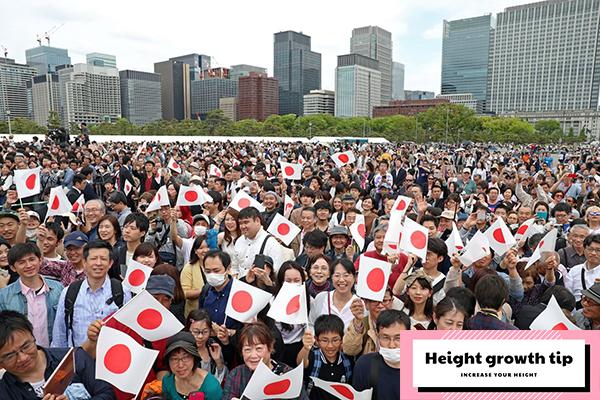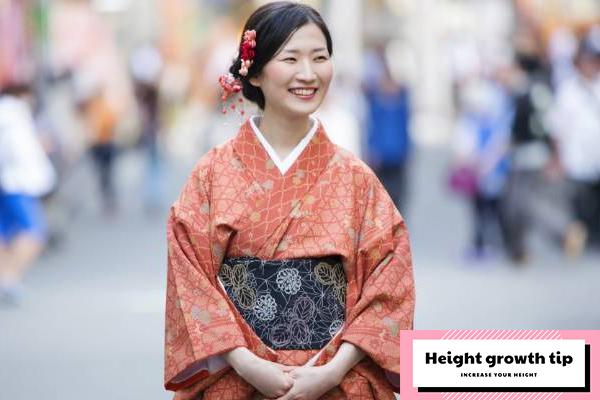In recent years, the remarkable shift in average height among the Japanese population has become a topic of fascination not only in neighboring Asian countries but also in Western academic circles. As Vietnamese individuals, this presents us with a unique opportunity to delve into the factors driving this change and glean insights that could potentially benefit us on a global scale. In this article, we embark on a journey to explore the evolution of height in Japan and unveil a comprehensive strategy to help individuals, ourselves included, in our quest for greater stature. Join us as we unravel the mysteries behind height enhancement and draw inspiration from the Japanese experience to chart our own path towards physical growth and development.
The Remarkable Evolution of Japanese Stature: A Tale of Growth and Resilience
In a captivating exploration by The New York Times, historical records unveil a captivating narrative chronicling the evolution of average height among the Japanese population. Prior to the mid-20th century, Japan bore the weight of a rather unique distinction; it was home to one of the world’s shortest average statures. Men stood at an average of approximately 150cm, while women measured in at just about 149cm. This diminutive stature earned them the moniker of “short Japanese,” a label that even fell below the average height observed in Vietnam.
The origins of this phenomenon of stunted growth ran deep, rooted in the aftermath of World War II, a period marked by the enduring scars of conflict and the enduring challenges of post-war life that left indelible marks, both physical and psychological. In the wake of the war, rural Japan found itself in dire straits, grappling with severe food shortages that translated into diets predominantly consisting of meager portions of vegetables and tofu, notably lacking in substantial meat content. This prolonged state of chronic malnutrition exacted a toll on the physical development and stature of the younger generation, perpetuating a cycle of diminished height.
Nevertheless, recognizing the adverse impact of this diminutive stature on the nation’s self-image and global standing, the Japanese government resolved to take bold and decisive action. Despite enduring economic hardships, Japan embarked on an ambitious mission to initiate a “height revolution,” with the primary goal of enhancing the stature of its citizens, particularly among the youth.
In the latter half of the 20th century, Japan’s pursuit of greater height witnessed an astonishing acceleration, characterized by a remarkable “catch-up” in terms of stature. Over the course of four decades, the average height of the Japanese populace surged by an astounding 10cm, representing an annual growth rate of 2.5cm—an achievement that left many in awe.
The tale of Japan’s transformation in height offers an invaluable lesson for nations worldwide, including Vietnam. It underscores the potential for implementing similar strategies to ascend the global height spectrum and achieve substantial enhancements in stature. This journey reflects not only physical growth but also the indomitable spirit and resilience of a nation determined to rise above the challenges of its past and reach new heights, both literally and metaphorically.

The Evolution of Japanese Height: A Tale of Scientific Advancement
As of my last update in September 2021, the average height of the Japanese population has been a subject of fascination, reflecting not just statistical figures but a captivating narrative of transformation. In the land of the rising sun, where tradition harmonizes with modernity, the average height of individuals has seen a remarkable surge over the years.
Standing tall at approximately 171 centimeters (equivalent to about 5 feet 7 inches) for men and around 158 centimeters (about 5 feet 2 inches) for women, these numbers paint a portrait of a nation that has undergone a profound metamorphosis. However, it’s imperative to acknowledge that these statistics may have experienced subtle shifts since my last update, owing to an array of factors that continually influence height trends.
The Rise of the Japanese Stature: A Scientific Revolution
The remarkable ascent in the average height of the Japanese population is a testament to a multifaceted scientific revolution that has reshaped the nation’s physical stature. This transformation is characterized by several key factors that have converged to elevate the Japanese people to new heights—both literally and figuratively.
Dietary Transformation: A Symphony of Nutrients
Central to this era of height enhancement has been a meticulous overhaul of dietary habits and nutritional intake. Japanese cuisine, known for its exquisite flavors, has evolved to embrace a symphony of nutrients essential for bone strength and optimal growth. Foods such as salmon, cod, seaweed, cabbage, broccoli, fermented soybeans, and tofu have found their way into daily meals, ensuring a delectable yet nutritionally balanced diet.
Milk Revolution: Nourishing the Future
A pivotal aspect of this transformation has been the widespread adoption of milk consumption, particularly within the education system. Japanese schools have made it a norm for students to partake in milk, with the quantity increasing as they progress through grades. The government’s commitment to height enhancement is evident through the implementation of a free school milk program, aimed at nurturing the physical development of the Japanese populace from a young age.
Genetic Advancements: Breeding Height
The Japanese government has actively encouraged individuals with exceptional height, often intellectuals, to procreate and pass on their advantageous genes. This proactive approach seeks to contribute to the perpetual amelioration of the nation’s stature in future generations, demonstrating a unique blend of science and policy in pursuit of height enhancement.
Promotion of Sports: A Cultural Embrace
In a concerted effort to instill a culture of physical fitness from a young age, the Japanese government has fervently promoted the establishment of sports clubs in schools. Students are mandated to join at least one sports club and engage in regular physical activities. Simultaneously, Japanese parents place significant emphasis on motivating their offspring to exercise at home, nurturing a culture of holistic well-being.
Moreover, a daily sports program, set to music and broadcast at 6 am, has become a cherished tradition in many Japanese households. Families gather each morning to participate in synchronized exercise routines, fostering familial unity and bolstering overall health, thereby contributing significantly to the nation’s ongoing journey towards greater height.
In conclusion, the evolution of the average height of the Japanese population is not merely a statistical phenomenon; it is a captivating narrative of scientific advancement, dietary transformation, genetic considerations, and a cultural embrace of physical fitness. To obtain the most up-to-date and precise information on the average height of the Japanese populace, I recommend consulting recent sources and studies dedicated to this subject matter.

Harnessing Nutrition for Height Advancement: A Japanese Endeavor
Throughout the annals of history, the Japanese people have ardently acknowledged the pivotal role that nutrition plays in the pursuit of increased stature. Their culinary choices have evolved into a cornerstone of their collective aspiration to elevate the average height of their population. Through meticulous selection and consumption of nutritionally dense foods, the Japanese actively cultivate bone development and overall growth.
At the heart of this dietary quest for height enhancement lie a myriad of staple ingredients:
1. Seafood: Notably, the Japanese hold varieties like salmon and cod in high esteem. These fish serve as abundant reservoirs of protein, omega-3 fatty acids, and essential minerals like calcium. These elements are the bedrock of robust bone health and the catalysts that drive physical growth.
2. Seaweed: Seaweed emerges as a treasure trove of essential vitamins and minerals, with iodine standing as a crucial element that regulates thyroid function and plays a pivotal role in growth.
3. Vegetables: Within the verdant realms of their diet, vegetables such as cabbage and broccoli take center stage. Bursting with nutrients like vitamin C, vitamin K, and fiber, they offer multifaceted support for overall health and the gradual ascent towards greater stature.
4. Fermented Soybeans: The products derived from fermented soybeans, such as tofu, natto, and miso, are celebrated for their abundant protein, calcium, and a plethora of other vital nutrients that fortify growth and skeletal strength.
5. Dairy Products: The inclusion of milk and dairy items like yogurt amplifies calcium intake, laying the cornerstone for bone development and the realization of untapped growth potential.
By artfully weaving these nutrient-rich elements into their daily culinary repertoire and crafting well-balanced meals, the Japanese population aspires not merely to satisfy their palates but to unlock their full growth potential and maintain a robust physical stature. This unwavering dedication to nutritional excellence, when combined with genetic factors and a commitment to physical activity, emerges as a significant catalyst behind the observed increase in the average height of the Japanese populace over the course of time.
The Tapestry of Family Care: Nurturing Holistic Development
Within the intricate tapestry of nurturing children’s physical, emotional, and mental well-being, the concept of family care stands as a cornerstone. In Japan, a nation steeped in rich cultural traditions, the importance of family care is paramount, as parents and caregivers employ a myriad of strategies to ensure the optimal upbringing of their offspring.
Emotional Nurturing: Japanese families prioritize the cultivation of emotional well-being in their children. They painstakingly create an environment suffused with warmth and affection, where children bask in a cocoon of safety and comfort. Positive reinforcement, unwavering encouragement, and open channels of communication are the norm in these households.
Educational Dedication: Education, revered as a sacred pillar in Japanese culture, receives unwavering devotion from parents. They actively engage in their children’s scholastic journey, providing unwavering support and additional resources to fortify their academic prowess. This dedication instills a strong work ethic and a resolute commitment to the pursuit of knowledge.
Health and Nutritional Excellence: Japanese families place a premium on their children’s health and overall well-being by meticulously curating balanced and nutritious diets. Recognizing the pivotal role of nutrition in the growth process, parents ensure their children are nourished with foods teeming with vital nutrients, further nurturing their physical development.
The Art of Discipline: While showering their young ones with affection, Japanese parents also instill the virtues of discipline and responsibility. They impart essential values and delineate clear boundaries, fostering the development of self-discipline and a profound respect for others.
Championing Physical Activity: Physical fitness receives a resounding endorsement within Japanese households. Engaging in sports and regular exercise is actively encouraged, fostering physical robustness, strength, and overall well-being.
In the intricate weave of family care, Japan shines as an exemplar of holistic child nurturing, where the physical, emotional, and mental growth of the younger generation is nurtured with unwavering dedication and care.
Related post: Top 20 Healthy Drinks That Make You Taller
